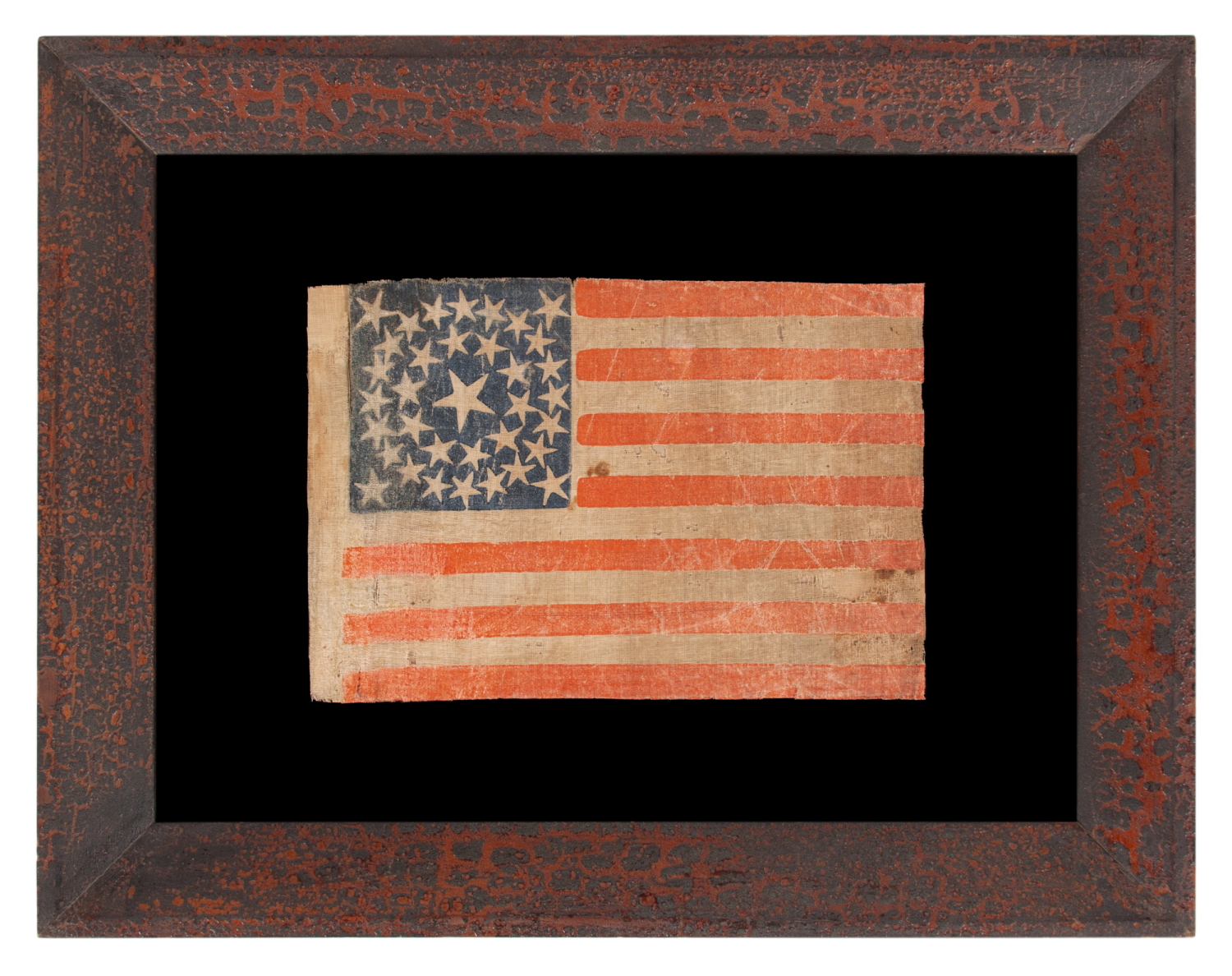
| |
35 WHIMSICALLY SHAPED STARS IN A DOUBLE-WREATH PATTERN, ON AN ANTIQUE AMERICAN FLAG OF THE CIVIL WAR PERIOD, 1863-65, WEST VIRGINIA STATEHOOD, A RARE AND VISUALLY INTERESTING VARIETY |
|
| Available: |
Sold |
| Frame Size (H x L): |
13.75" x 17.5" |
| Flag Size (H x L): |
6.5" x 9.75" |
|
| Description....: |
|
35 star American national parade flag of the Civil War period, printed on coarse, glazed cotton. Note the beautiful medallion star configuration, that consists of two wreaths of stars, surrounding a large center star, with a flanking star in each corner of the blue canton. Note how the stars of this particular variety have unusually elongated arms, which adds a nice degree of folk quality to the design. Traits like this add the sort of visual presentation that is of importance to collectors.
Though the name of the maker remains unknown, I have identified other star counts that were almost certainly produced by the same firm or individual. Parade flags that have stars with the same, unusual shape also exist with star counts of 29, 33, and 34, as well as three other styles. These include 13 star examples, made to represent the original 13 colonies, 15 star examples that may reflect Kentucky statehood, and both 7 and 8 star, Confederate sympathizer flags, with the respective counts to reflect the initial wave of 7 states to secede from the Union, and then 8 states when Virginia joined the list. All of these flags appear in the same general era and are likely from the same manufacturer. Of the seven different star counts, it is interesting to note that the 35 star examples are among the most rare. I know of perhaps 12-15 to exist. In addition, those in the 35 star count are slightly more square in shape than their counterparts, and their center star is proportionally larger (a trait it shares with the 15 star examples), both of which are factors that influence collectability.
West Virginia broke off from Virginia and was admitted into the Union as the 35th state (a Free State) on June 20th, 1863. This took place in the midst of the Civil War, eleven days before the battle of Gettysburg, which occurred from July 1st-3rd. The 35th star was thus officially added on the following day, and the 35 star flag remained official until the July 4th, 1865, after the war’s close.
In the meantime, Nevada joined the Union as the 36th state on October 31st, 1864, a few days before Lincoln’s second election. Not wanting to produce flags that would soon be out-of-date, most flag-makers would have included a 36th star upon Nevada’s admission. This meant that 35 star flags were realistically produced for less than a year-and-a-half. Scarcity is one reason why 35 star flags are so interesting. Far fewer flags are known in this count than in the 34 star count that proceeded it, or the 36 star count that followed.
It is interesting to note that a small group of the known examples in this design were found in Southern Ohio, along with 15 star examples from the same maker. Southern Ohio borders both West Virginia and Kentucky, the two states which these flags reflect. It’s actually unusual to find flags with star counts specific to a state, within that exact state. Though certainly inconclusive, the discovery of these two styles in a nearby, bordering state, does suggests some geographical relationship, maybe not of manufacture, but probably of use.
Mounting: The flag was mounted and framed within our own conservation department, which is led by expert staff. We take great care in the mounting and preservation of flags and have framed thousands of examples.
The frame, with its outstanding, early surface, with heavy craquelure, dates to the period between approximately 1840-1860, and is thus of the same general era as the flag. The background is 100% cotton twill, black in color, that has been washed and treated for colorfastness. The glazing is U.V. protective acrylic (Plexiglas).
Condition: There are minor to modest holes and losses throughout, primarily in the white areas of the fabric, accompanied by a more significant area, along the hoist, at the top, and in the 5th white stripe, near the fly end, and a vertical separation along about half of the height of the canton, along the hoist end. There is modest to moderate soiling, most significant along the fly end, and there a few darker stains in the striped field, near the bottom, fly end corner of the canton, and at the end of the 5th white stripe. Fabric of similar coloration was placed behind these areas for masking purposes, as well as along the last red stripe (period, parade fabric was used in this instance). There is minor to significant pigment loss in both the red and blue areas. Minor, professional color restoration was undertaken to improve their appearance, at and just adjacent to the hoist end, with a reversible medium. Many of my clients prefer early flags to show their age and history of use. Further, the rarity of this example warrants its condition issues. |
|
|
|
| Collector Level: |
Advanced Collectors and the Person with Everything |
|
| Flag Type: |
Parade flag |
|
| Star Count: |
35 |
|
| Earliest Date of Origin: |
1863 |
|
| Latest Date of Origin: |
1865 |
|
| State/Affiliation: |
West Virginia |
|
| War Association: |
1861-1865 Civil War |
|
| Price: |
SOLD |
|
| |
Views: 975 |
|
|
|

